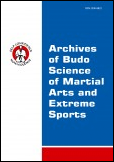2015, Volume 11, Issue 1
Fighting profiles in men's taekwondo competition in the under 68 kg category at the Olympic Games in Beijing (2008) and London (2012) – case studies
Dariusz Śledziewski1, Michał Łoniewski2, Anna Kuder1, Ronaldo Angelo Dias da Silva3, Gustavo Ferreira Pedrosa3, Bruno Pena Couto3, Leszek Antoni Szmuchrowski3
1The Józef Piłsudski University of Physical Education, Department of Theory of Sport, Warsaw, Poland, Warszawa, Poland
2The Józef Piłsudski University of Physical Education, Research Club of Department of Theory of Sport Department, Warsaw, Poland, Warszawa, Poland
3Federal University of Minas Gerais, Load Evaluation Laboratory, Brazil, Minas Gerais, Brazil
Full text
Abstract
Background & Study Aim: Taekwondo WTF, together with wrestling, judo, and boxing, is a combat sports that is part of the Olympic Games programme. The changes occurring in refereeing rules of this competition influence its course. These recent changes in regulations, such as the introduction of additional points for kicks to the head and the introduction of an electronic hogo protector with the dae-do system, will definitely affect the course of sparring itself as well as training solutions. The purpose of this study was to answer the question: whether the changes in regulations that were introduced between the Beijing Olympics (2008) and the London Olympics (2012), influenced the content and profile of sparring in the under 68 kg men's taekwondo WTF.
Material and Methods: The research data comprised two matched between athletes weighing up to 68 kg. The contests had been recorded on DVD. The athletes were ST, a representative of Turkey who was both a bronze medallist at the Beijing Olympics and an Olympic champion at the London Olympics, and RN, an athlete from Afghanistan who was both a bronze medallist at the Beijing Olympics and a bronze medallist at the London Olympics. Both fighters participated in four fights at both Olympic Games. The under 68 kg weight category is the most popular category in Olympic taekwondo.
Results: It has been established that in subsequent Olympic Games (2008 and 2012) the profile used in taekwondo techniques changed. By increasing the ratio of front leg usage in relation to the back leg and increasing the number of actions aimed at the head, he clearly adapted to changes in regulations.
Conclusion: The change in the point system and the introduction of electronic trunk protectors changed the frequency and effectiveness of the techniques used, and thus altered the dominant technical profile of a taekwondo contest.
Key words: change competition rules, combat sports, electronic trunk protector





